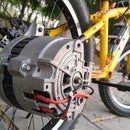Introduction: DIY LED Flasher Light
Out there basing my RC truck around as the sun set and I started to face problem to find the correct orientation. So I just thought to built a flasher light for myself.
So in this instructables I am going to show you how a flasher light works and later we make one for ourself.
Step 1: Schematic and Working
The idea is to built a Police/emergency style flasher light which composes of two sets of LEDs. We have to light the sets alternately and preferably with adjustable frequency.
So the whole setup is based around the 555 timer IC. To control the output frequency of the timer IC I have used a 100 potentiometer as a variable resistor. Since 555 timer have only one output so to split the output into two halves to light up two different sets of LEDs we are going to add a counter next to it which is CD4017 IC. Now the Counter IC provides us 10 outputs that goes high corresponding to the output pulse from the 555 timer IC. So we can form two different sets of outputs to light up individual pair of LEDs alternately. In this particular case I decided to form sets of three outputs to drive each set of LEDs. Now that what I decided to go with but you can go as much as 5 outputs per set to make the LEDs blink 5 times before alternating with the other set of LEDs.
The rest of the components you see are a bunch of complimentary components as advised in the data sheet.
Datasheets for 555 timer IC and CD4017 counter IC:
http://www.ti.com/lit/ds/symlink/lm555.pdf
Step 2: Tools and Materials
All you need for this project are a bunch of basic soldering tools and some basic soldering skills.
Moreover, the list of components is given in the attached BOM (Bill Of Material):
Attachments
Step 3: Designing and Ordering the PCBs
Well guys I know we are heading the long route now as we can get things done on a perfboard too. Thats what I always preferred back when I haven't built anything on a Printed Circuit Board (PCB). But ever since I started to built my DIY projects on dedicated PCB I just love the end results and ease of producing multiple copies later.
So for this project I did put extra effort to design the PCBs and later ordered them from PCBWAY. After going through a bunch of options I just uploaded the Gerber files for my PCBs. The best part about these guys are that your design will be reviewed and the will let you know in case if there is any issue with the design.
They are also having a 2nd PCB Design contest so have a look at it to win some great prizes.
Within just a week I have received the PCBs and the boards were as flawless as the seems like.
Attachments
Step 4: Assembling the PCB
As I got my hands on the PCBs all I need to do was to drop down all the components as stated on the boards. You can start by laying all the complimentary components like resistors, diodes and then moving towards the bigger components. We can solder both the timer and the counter ICs directly to the boards but for the convenience of replacing the faulty IC later I decided to go with IC holders. While placing these IC holders make sure to place the notch as indicated on the board. Same goes with the LEDs, a notch is indicated on the board that you have to match with the notch provided on each side of the LED while placing it.
Once you are done soldering all the components on the PCB you can now drop your 555 timer and CD4017 counter in there holders.
With that hopefully our job is done and thats the advantage of putting up so much time earlier to design the PCBs so that now I can produce as many flasher lights as I want.
Step 5: Final Results
Now to power the flasher light we connected it to a 12v lead acid battery. As I toggled the switch, everything worked as expected.
The frequency of blinks between the two sets of LEDs can easily be controlled by turning the knob of the pot.
The flasher light looks flawless and the dedicated Printed Circuit Boards have added a touch of perfection tot the whole project.
Regards.
DIY King

Participated in the
PCB Contest












